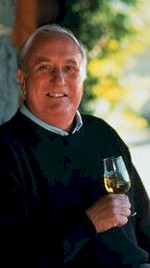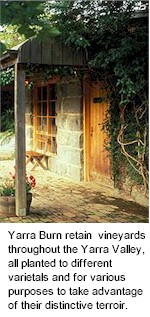


In the spring that followed they erected makeshift houses to stay in while they planted vines on their days off from running Mayerling Cellars. Initial plantings were 2 acres each of pinot noir, cabernet sauvignon and half an acre of gewrztraminer, which was fairly quickly replanted with merlot when it lost popularity. The original name Settlement Vineyards was already registered so they settled on Yarra Burn, as the property is located half way between the two small townships of Yarra Junction and Wesburn. Part time study in viticulture and oenology at Roseworthy and Charles Sturt and help from consultants contributed to Yarra Burn's success. In late 1977 the Fyffes sold their bottleshop to build a house and an estate winery at Yarra Burn. They were encouraged and assisted by their friends at Jean Jacques by the Sea in establishing an onsite restaurant.

The first wines were released from the vintage of 1978, two editions of shiraz from grapes grown to other Yarra Valley vineyards. The first was the Launching Place Shiraz and the other was a Shiraz from what is now the Yarra Yering Vineyard in Coldstream. In the spring of 1978 they expanded the vineyard and planted chardonnay to add to the range. The operations grew and Yarra Burn went on to experience great success in wine competitions in the mid-eighties, the Pinot Noir and Cabernet Sauvignon from 1984 receiving 8 Gold Medals and 7 trophies between them.
It is only with great patience involving 30 years of experience and experimentation, that the winemakers at Yarra Burn have found the perfect sites for each noble variety and, from them, nurtured wines of unique elegance and finesse. David and Christine Fyffe reckon that the Yarra Burn site chose itself, really. The cool breezes that sweep over the vineyard from the mountain peaks are replaced by the blissful warmth of the afternoon sun. The soil is fertile. And winter rain is plentiful. But don't let that fool you, this idyllic setting exacts a price. Every detail has to be just so.
The Yarra Valley is Victoria's oldest winegrowing region, and the coldest on the Australian mainland. Unlike the typical homogeneous, flat and warm-climate regions of Australia, the Yarra Valley is despite its singular name actually a series of valleys framed to the east by the Great Dividing Range and dominated by the majestic Mount Donna Buang. What these valleys have in common is that they all drain into the Yarra River. But the region is characterised by startling differences in soil composition, sun exposure, altitude and accessibility.

The terroir changes noticeably from hill to hill and sometimes even on the same hill. Naturally, this presents a winemaker with a vast palette of opportunities (including innumerable ways to go wrong). Little wonder that the region foundered in the 1930s. In the 1960s, however, the Yarra Valley found a new awakening. And Yarra Burn was one of the pioneers of this second wave, encouraged and intrigued by its obvious potential.
The south-facing slope of one hill at Yarra Burn is mountain-goat steep. That's why, to quote the brave souls who have to work it, it's become known as Bastard Hill. Needless to say, it's a risky place to work, ideally requiring one leg that's 15 centimetres shorter than the other for maximum stability. But it's also a risky place to grow grapes. Facing south and being so high, grapes take an inordinate amount of time to ripen. So those years when the grapes are at their zenith (and only those years), Yarra Burn favour them with kid-gloves treatment to make wine under the Bastard Hill label.
The chardonnay fruit is 100% hand-picked, bunch-pressed, barrel fermented in a combination of new and used French oak and then given malo-lactic fermentation. Likewise for the pinot noir, the bunches are hand-picked, placed in open-top fermenters and the cap is plunged by hand. The result is a benchmark, finely structured, richly flavoured and surprisingly long-lived wine. Not surprisingly, they're a bastard to find supplies of too.
Every uphill step of the way, making wine here is a hands-on, labour-intensive process. But it is, after all, a labour of love. Because what all of this intensive work yields is intensive fruit. The flavours are complex. And the wines tend to accept more of the winemaker's craft without losing their natural balance. They also thrive in the exclusively French oak which induces finer tannins than its American counterpart.
